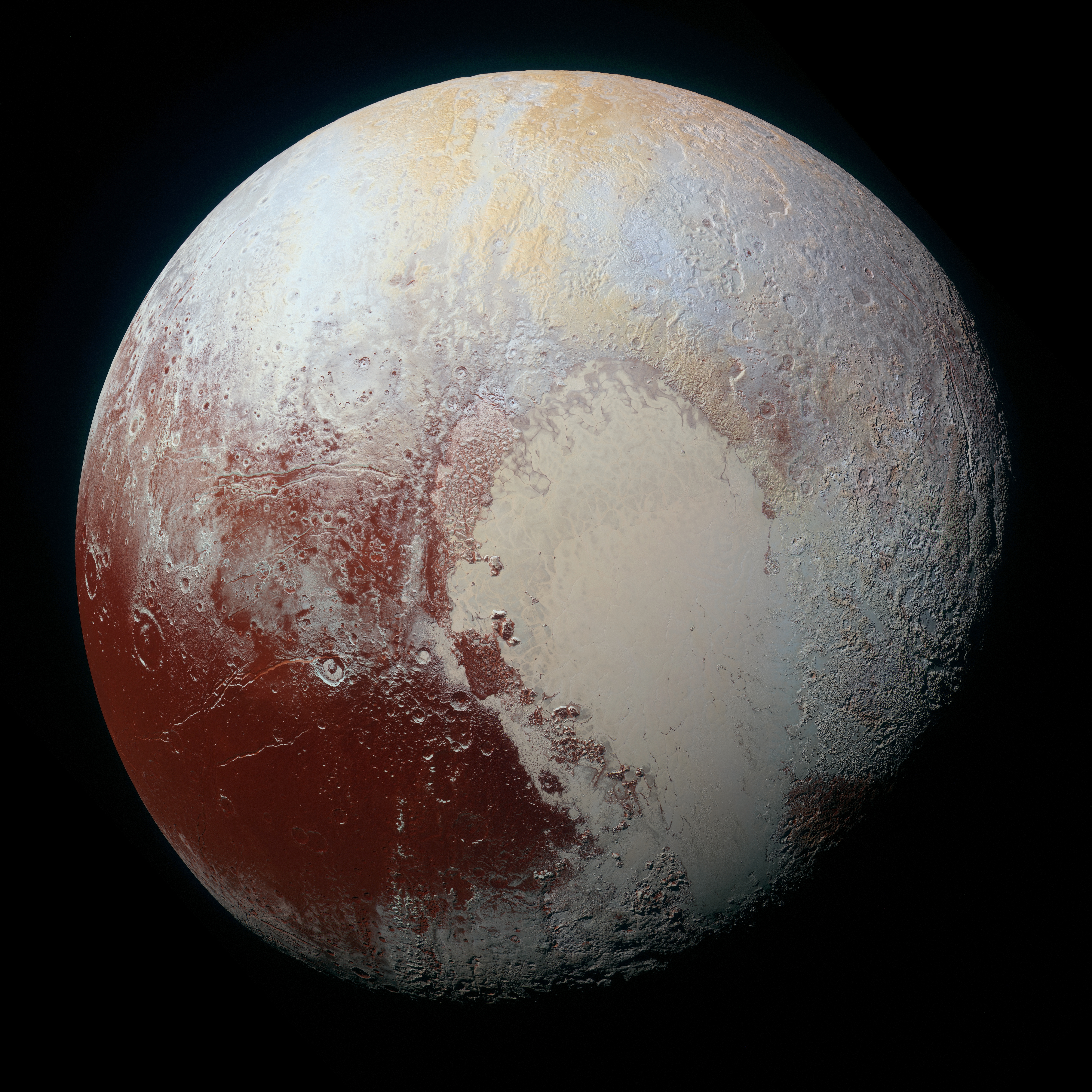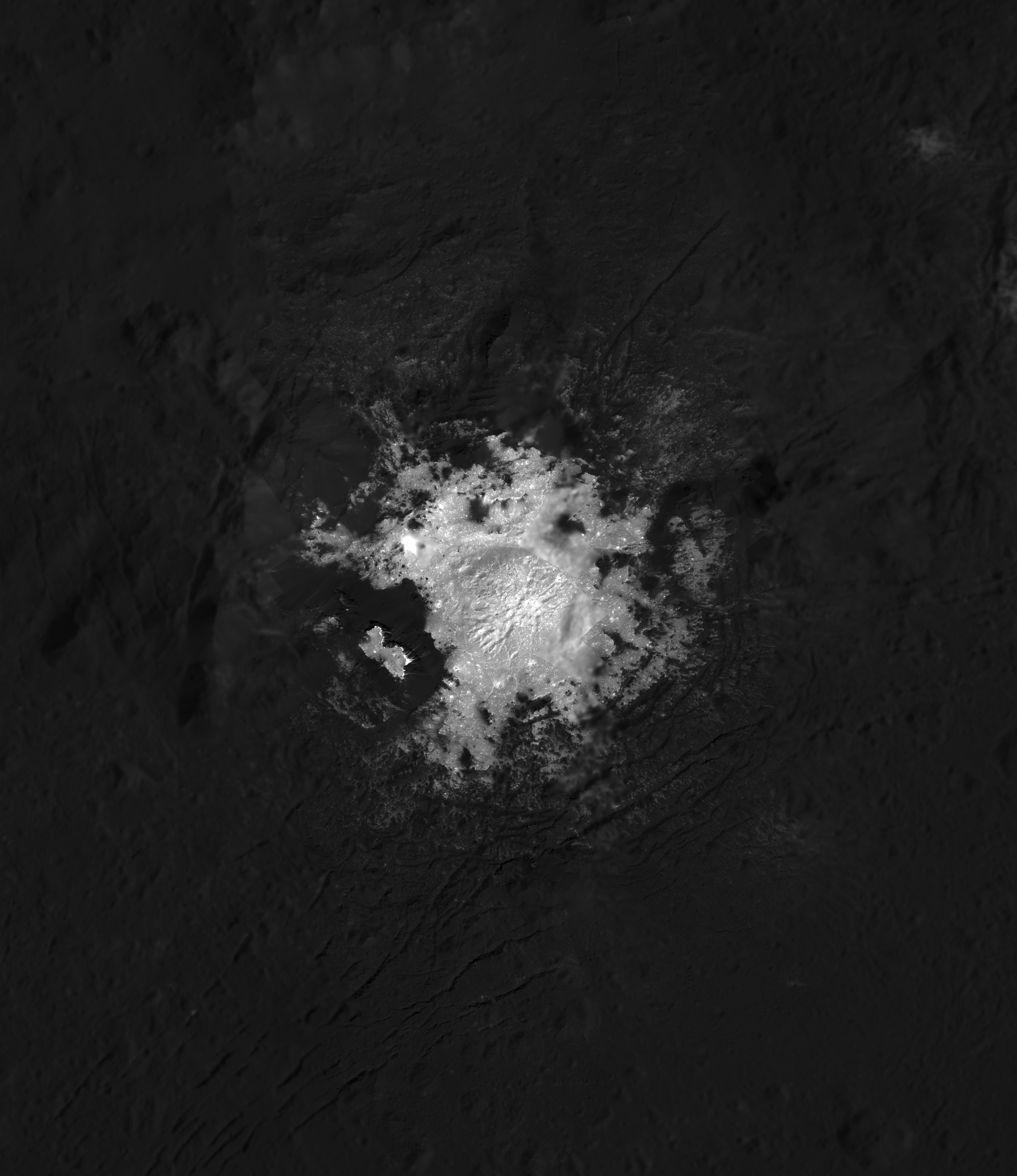|
Facula
A facula (plural: faculae ), Latin for "little torch", is literally a "bright spot". The term has several common technical uses. It is used in planetary nomenclature for naming certain surface features of planets and moons,. and is also a type of surface phenomenon on the Sun's photosphere. In addition, a bright region in the projected field of a light source is sometimes referred to as a facula, and photographers often use the term to describe bright, typically circular features in photographs that correspond to light sources or bright reflections in a defocused image. Solar facula Solar faculae are bright spots in the photosphere that form in the canyons between solar granules, short-lived convection cells several thousand kilometers across that constantly form and dissipate over timescales of several minutes. Faculae are produced by concentrations of magnetic field lines. Strong concentrations of faculae appear in solar activity, with or without sunspots. The faculae and t ... [...More Info...] [...Related Items...] OR: [Wikipedia] [Google] [Baidu] |
Solar Phenomena
Solar phenomena are natural phenomena which occur within the atmosphere of the Sun. These phenomena take many forms, including solar wind, radio wave flux, solar flares, coronal mass ejections, coronal heating and sunspots. These phenomena are believed to be generated by a helical dynamo, located near the center of the Sun's mass, which generates strong magnetic fields, as well as a chaotic dynamo, located near the surface, which generates smaller magnetic field fluctuations. The total sum of all solar fluctuations is referred to as solar variation. The collective effect of all solar variations within the Sun's gravitational field is referred to as space weather. A major weather component is the solar wind, a stream of plasma released from the Sun's upper atmosphere. It is responsible for the aurora, natural light displays in the sky in the Arctic and Antarctic. Space weather disturbances can cause solar storms on Earth, disrupting communications, as well as geomagnetic ... [...More Info...] [...Related Items...] OR: [Wikipedia] [Google] [Baidu] |
Plage (astronomy)
A plage is a bright region in the Sun's chromosphere, typically found in and around active regions. Historically, they have been referred to as ''bright flocculi'', in contrast to dark flocculi, and as ''chromospheric faculae'', in contrast to photospheric faculae. Etymology The term is often believed to be poetically taken from the French word for "beach"; however, this is likely a misunderstanding of an 1893 article by Henri-Alexandre Deslandres where the name ''facular flames'' was suggested. In the article, Deslandres also refers to them as ''plages brillantes'', meaning ''bright regions'', which became the more commonly used term. Description Classically plage have been defined as regions that are bright in Hα and other chromospheric emission lines. but nowadays most researchers identify plage based on the photospheric magnetic field concentration of the faculae below. The magnetic field of plage is confined to the intergranular lanes in the photosphere with a strengt ... [...More Info...] [...Related Items...] OR: [Wikipedia] [Google] [Baidu] |
Ceres (dwarf Planet)
Ceres (; minor-planet designation: 1 Ceres) is a dwarf planet in the asteroid belt between the orbits of Mars and Jupiter. It was the first asteroid discovered, on 1 January 1801, by Giuseppe Piazzi at Palermo Astronomical Observatory in Sicily and announced as a new planet. Ceres was later classified as an asteroid and then a dwarf planetthe only one always inside Neptune's orbit. Ceres's small size means that even at its brightest, it is too dim to be seen by the naked eye, except under extremely dark skies. Its apparent magnitude ranges from 6.7 to 9.3, peaking at opposition (when it is closest to Earth) once every 15- to 16-month synodic period. As a result, its surface features are barely visible even with the most powerful telescopes, and little was known about it until the robotic NASA spacecraft ''Dawn'' approached Ceres for its orbital mission in 2015. ''Dawn'' found Ceres's surface to be a mixture of water ice, and hydrated minerals such as carbonates and cla ... [...More Info...] [...Related Items...] OR: [Wikipedia] [Google] [Baidu] |
Planetary Nomenclature
Planetary nomenclature, like terrestrial nomenclature, is a system of uniquely identifying features on the surface of a planet or natural satellite so that the features can be easily located, described, and discussed. Since the invention of the telescope, astronomers have given names to the surface features they have discerned, especially on the Moon and Mars. To found an authority on planetary nomenclature, the International Astronomical Union (IAU) was organized in 1919 to designate and standardize names for features on Solar System bodies. How names are approved by the IAU When images are first obtained of the surface of a planet or satellite, a theme for naming features is chosen and a few important features are named, usually by members of the appropriate IAU task group (a commonly accepted planet-naming group). Later, as higher resolution images and maps become available, additional features are named at the request of investigators mapping or describing specific surfaces ... [...More Info...] [...Related Items...] OR: [Wikipedia] [Google] [Baidu] |
Bright Spots On Ceres
Several bright surface features (also known as faculae) were discovered on the dwarf planet Ceres by the ''Dawn'' spacecraft in 2015. The brightest cluster of spots ("Spot 5") is located in an crater called Occator. The largest and brightest component of the cluster is in the center of the crater, with dimmer spots located towards this crater's eastern rim. Early in the orbital phase of the ''Dawn'' mission, the high albedo of these spots was speculated to be due to some kind of outgassing, and subsequent closer images helped scientists determine that it is a material with a high level of reflection, and suggested ice and salt as possibilities. These bright features have an albedo of about 40%, four times brighter than the average of Ceres's surface. On 9 December 2015, scientists reported that the bright spots on Ceres may be related to a type of salt, particularly a form of brine containing hydrated magnesium sulfate (MgSO4·6H2O); the spots were also found to be associ ... [...More Info...] [...Related Items...] OR: [Wikipedia] [Google] [Baidu] |
Photosphere
The photosphere is a star's outer shell from which light is radiated. The term itself is derived from Ancient Greek roots, φῶς, φωτός/''phos, photos'' meaning "light" and σφαῖρα/''sphaira'' meaning "sphere", in reference to it being a spherical surface that is perceived to emit light. It extends into a star's surface until the plasma becomes opaque, equivalent to an optical depth of approximately , or equivalently, a depth from which 50% of light will escape without being scattered. A photosphere is the deepest region of a luminous object, usually a star, that is transparent to photons of certain wavelengths. Temperature The surface of a star is defined to have a temperature given by the effective temperature in the Stefan–Boltzmann law. Stars, except neutron stars, have no solid or liquid surface. Therefore, the photosphere is typically used to describe the Sun's or another star's visual surface. Composition of the Sun The Sun is composed primari ... [...More Info...] [...Related Items...] OR: [Wikipedia] [Google] [Baidu] |
Sunspots
Sunspots are phenomena on the Sun's photosphere that appear as temporary spots that are darker than the surrounding areas. They are regions of reduced surface temperature caused by concentrations of magnetic flux that inhibit convection. Sunspots appear within active regions, usually in pairs of opposite magnetic polarity. Their number varies according to the approximately 11-year solar cycle. Individual sunspots or groups of sunspots may last anywhere from a few days to a few months, but eventually decay. Sunspots expand and contract as they move across the surface of the Sun, with diameters ranging from to . Larger sunspots can be visible from Earth without the aid of a telescope. They may travel at relative speeds, or proper motions, of a few hundred meters per second when they first emerge. Indicating intense magnetic activity, sunspots accompany other active region phenomena such as coronal loops, prominences, and reconnection events. Most solar flares and corona ... [...More Info...] [...Related Items...] OR: [Wikipedia] [Google] [Baidu] |
Occator Crater
Occator is an impact crater located on Ceres, the largest object in the main asteroid belt that lies between the orbits of Mars and Jupiter, that contains "Spot 5", the brightest of the bright spots observed by the Dawn spacecraft. It was known as "Region A" in ground-based images taken by the W. M. Keck Observatory on Mauna Kea. The crater was named after Occator, the Roman god of the harrow and a helper to Ceres. The name Occator was officially approved by the IAU on 3 July 2015. On 9 December 2015, scientists reported that the bright spots on Ceres, including those in Occator, may be related to a type of salt, particularly a form of brine containing magnesium sulfate hexahydrite (MgSO4·6H2O); the spots were also found to be associated with ammonia-rich clays. More recently, on 29 June 2016, scientists reported the bright spot to be mostly sodium carbonate (), implying that hydrothermal activity was probably involved in creating the bright spots. In August 2020, NASA c ... [...More Info...] [...Related Items...] OR: [Wikipedia] [Google] [Baidu] |
USGS
The United States Geological Survey (USGS), formerly simply known as the Geological Survey, is a scientific agency of the United States government. The scientists of the USGS study the landscape of the United States, its natural resources, and the natural hazards that threaten it. The organization's work spans the disciplines of biology, geography, geology, and hydrology. The USGS is a fact-finding research organization with no regulatory responsibility. The agency was founded on March 3, 1879. The USGS is a bureau of the United States Department of the Interior; it is that department's sole scientific agency. The USGS employs approximately 8,670 people and is headquartered in Reston, Virginia. The USGS also has major offices near Lakewood, Colorado, at the Denver Federal Center, and Menlo Park, California. The current motto of the USGS, in use since August 1997, is "science for a changing world". The agency's previous slogan, adopted on the occasion of its hundredth ... [...More Info...] [...Related Items...] OR: [Wikipedia] [Google] [Baidu] |
NASA
The National Aeronautics and Space Administration (NASA ) is an independent agency of the US federal government responsible for the civil space program, aeronautics research, and space research. NASA was established in 1958, succeeding the National Advisory Committee for Aeronautics (NACA), to give the U.S. space development effort a distinctly civilian orientation, emphasizing peaceful applications in space science. NASA has since led most American space exploration, including Project Mercury, Project Gemini, the 1968-1972 Apollo Moon landing missions, the Skylab space station, and the Space Shuttle. NASA supports the International Space Station and oversees the development of the Orion spacecraft and the Space Launch System for the crewed lunar Artemis program, Commercial Crew spacecraft, and the planned Lunar Gateway space station. The agency is also responsible for the Launch Services Program, which provides oversight of launch operations and countdown m ... [...More Info...] [...Related Items...] OR: [Wikipedia] [Google] [Baidu] |
Sodium Carbonate
Sodium carbonate, , (also known as washing soda, soda ash and soda crystals) is the inorganic compound with the formula Na2CO3 and its various hydrates. All forms are white, odourless, water-soluble salts that yield moderately alkaline solutions in water. Historically, it was extracted from the ashes of plants growing in sodium-rich soils. Because the ashes of these sodium-rich plants were noticeably different from ashes of wood (once used to produce potash), sodium carbonate became known as "soda ash". It is produced in large quantities from sodium chloride and limestone by the Solvay process. Hydrates Sodium carbonate is obtained as three hydrates and as the anhydrous salt: * sodium carbonate decahydrate (natron), Na2CO3·10H2O, which readily effloresces to form the monohydrate. * sodium carbonate heptahydrate (not known in mineral form), Na2CO3·7H2O. * sodium carbonate monohydrate (thermonatrite), Na2CO3·H2O. Also known as crystal carbonate. * anhydrous sodium carbonate ( n ... [...More Info...] [...Related Items...] OR: [Wikipedia] [Google] [Baidu] |


.jpg)


_2007-04-30_T001456.gif)


